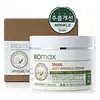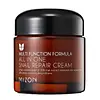What's inside
What's inside
 Key Ingredients
Key Ingredients

 Benefits
Benefits

 Concerns
Concerns

 Ingredients Side-by-side
Ingredients Side-by-side

Achillea Millefolium Extract
CleansingAdenosine
Skin ConditioningAlcohol
AntimicrobialAllantoin
Skin ConditioningArnica Montana Flower Extract
MaskingArtemisia Absinthium Extract
Skin ConditioningButylene Glycol
HumectantCetearyl Alcohol
EmollientCyclopentasiloxane
EmollientDimethicone
EmollientGentiana Lutea Root Extract
Skin ConditioningGlycerin
HumectantGlyceryl Stearate
EmollientPentaerythrityl Tetraethylhexanoate
EmollientNiacinamide
SmoothingPolysorbate 60
EmulsifyingPEG-100 Stearate
Palmitic Acid
EmollientStearic Acid
CleansingSodium Polyacrylate
AbsorbentSorbitan Stearate
EmulsifyingSodium Acrylate/Sodium Acryloyldimethyl Taurate Copolymer
Emulsion StabilisingTuna Extract
Skin ConditioningDisodium EDTA
Propylparaben
PreservativePotassium Sorbate
PreservativeCI 15985
Cosmetic ColorantCI 19140
Cosmetic ColorantParfum
MaskingAchillea Millefolium Extract, Adenosine, Alcohol, Allantoin, Arnica Montana Flower Extract, Artemisia Absinthium Extract, Butylene Glycol, Cetearyl Alcohol, Cyclopentasiloxane, Dimethicone, Gentiana Lutea Root Extract, Glycerin, Glyceryl Stearate, Pentaerythrityl Tetraethylhexanoate, Niacinamide, Polysorbate 60, PEG-100 Stearate, Palmitic Acid, Stearic Acid, Sodium Polyacrylate, Sorbitan Stearate, Sodium Acrylate/Sodium Acryloyldimethyl Taurate Copolymer, Tuna Extract, Disodium EDTA, Propylparaben, Potassium Sorbate, CI 15985, CI 19140, Parfum
Water
Skin ConditioningSnail Secretion Filtrate
Skin ConditioningButylene Glycol
Humectant1,2-Hexanediol
Skin ConditioningCetearyl Olivate
Sorbitan Olivate
EmulsifyingCetearyl Alcohol
EmollientGlyceryl Stearate
EmollientDimethicone
EmollientHydrogenated Vegetable Oil
EmollientPalmitic Acid
EmollientStearic Acid
CleansingPolyacrylate-13
Dipropylene Glycol
HumectantTriethanolamine
BufferingCarbomer
Emulsion StabilisingHydroxyacetophenone
AntioxidantPEG/PPG-17/6 Copolymer
SolventPolyisobutene
Sodium Polyacrylate
AbsorbentCaprylyl Glycol
EmollientAdenosine
Skin ConditioningPolysorbate 20
EmulsifyingSorbitan Isostearate
EmulsifyingDisodium EDTA
Dipotassium Glycyrrhizate
HumectantGlycerin
HumectantAlcohol
AntimicrobialPortulaca Oleracea Extract
Skin ConditioningBetula Platyphylla Japonica Juice
Skin ConditioningArtemisia Absinthium Extract
Skin ConditioningArnica Montana Flower Extract
MaskingGentiana Lutea Root Extract
Skin ConditioningFragaria Chiloensis Fruit Extract
Skin ConditioningAchillea Millefolium Extract
CleansingRubus Idaeus Fruit Extract
AstringentCamellia Sinensis Leaf Extract
AntimicrobialPalmitoyl Tripeptide-5
Skin ConditioningPropylene Glycol
HumectantCentella Asiatica Extract
CleansingCitric Acid
BufferingSodium Hyaluronate
HumectantBeta-Glucan
Skin ConditioningPotassium Sorbate
PreservativeCopper Tripeptide-1
Skin ConditioningFragaria Vesca Fruit Extract
AstringentEthylhexylglycerin
Skin ConditioningMadecassoside
AntioxidantMadecassic Acid
Skin ConditioningAsiaticoside
AntioxidantAsiatic Acid
Skin ConditioningWater, Snail Secretion Filtrate, Butylene Glycol, 1,2-Hexanediol, Cetearyl Olivate, Sorbitan Olivate, Cetearyl Alcohol, Glyceryl Stearate, Dimethicone, Hydrogenated Vegetable Oil, Palmitic Acid, Stearic Acid, Polyacrylate-13, Dipropylene Glycol, Triethanolamine, Carbomer, Hydroxyacetophenone, PEG/PPG-17/6 Copolymer, Polyisobutene, Sodium Polyacrylate, Caprylyl Glycol, Adenosine, Polysorbate 20, Sorbitan Isostearate, Disodium EDTA, Dipotassium Glycyrrhizate, Glycerin, Alcohol, Portulaca Oleracea Extract, Betula Platyphylla Japonica Juice, Artemisia Absinthium Extract, Arnica Montana Flower Extract, Gentiana Lutea Root Extract, Fragaria Chiloensis Fruit Extract, Achillea Millefolium Extract, Rubus Idaeus Fruit Extract, Camellia Sinensis Leaf Extract, Palmitoyl Tripeptide-5, Propylene Glycol, Centella Asiatica Extract, Citric Acid, Sodium Hyaluronate, Beta-Glucan, Potassium Sorbate, Copper Tripeptide-1, Fragaria Vesca Fruit Extract, Ethylhexylglycerin, Madecassoside, Madecassic Acid, Asiaticoside, Asiatic Acid
 Reviews
Reviews

Ingredients Explained
These ingredients are found in both products.
Ingredients higher up in an ingredient list are typically present in a larger amount.
Achillea Millefolium Extract comes from the yarrow plant. Yarrow is rich in antioxidants and fatty acids.
Adenosine is in every living organism. It is one of four components in nucleic acids that helps store our DNA.
Adenosine has many benefits when used. These benefits include hydrating the skin, smoothing skin, and reducing wrinkles. Once applied, adenosine increases collagen production. It also helps with improving firmness and tissue repair.
Studies have found adenosine may also help with wound healing.
In skincare products, Adenosine is usually derived from yeast.
Learn more about AdenosineAlcohol comes in many different forms. Different types of alcohol will have different effects on skin. This ingredient is usually an astringent alcohol.
These alcohols are drying on the skin. They may strip away your skin's natural oils and even damage your skin barrier. Astringent alcohols may also irritate skin.
Other types of astringent alcohols include:
According to the National Rosacea Society based in the US, you should be mindful of products with these alcohols in the top half of ingredients.
Any type of sanitizing product will have high amounts of alcohol to help kill bacteria and viruses.
Fatty alcohols come from plant oils such as coconut oil. These can help hydrate the skin and are non-irritating. Some fatty alcohols include cetyl and stearyl alcohol.
Learn more about AlcoholArnica Montana Flower is more commonly known as Wolf's Bane. While this flower has been used in traditional medicine, its skin benefits are in question.
The FDA considers Wolf's Bane to be an unsafe herb. They advise against taking it orally or applying it to broken skin.
Wolf's Bane has been said to have anti-inflammatory properties. However, studies are conflicting about whether this is true.
According to the Final report on the safety assessment of Arnica montana, this plant has not been found to cause dermal irritation.
This flower contains numerous fatty acids such as palmitic, linoleic, myristic, and linolenic acids. The presence and amount of fatty acids depends on where the flower is harvested.
Like other flowers, this ingredient has a natural fragrance. It can also be used to mask, or cover, the unpleasant scents from other ingredients.
Learn more about Arnica Montana Flower ExtractWe don't have a description for Artemisia Absinthium Extract yet.
Butylene Glycol (or BG) is used within cosmetic products for a few different reasons:
Overall, Butylene Glycol is a safe and well-rounded ingredient that works well with other ingredients.
Though this ingredient works well with most skin types, some people with sensitive skin may experience a reaction such as allergic rashes, closed comedones, or itchiness.
Learn more about Butylene GlycolCetearyl alcohol is a mixture of two fatty alcohols: cetyl alcohol and stearyl alcohol. It is mainly used as an emulsifier. Emulsifiers help prevent the separation of oils and products. Due to its composition, it can also be used to thicken a product or help create foam.
Cetearyl alcohol is an emollient. Emollients help soothe and hydrate the skin by trapping moisture.
Studies show Cetearyl alcohol is non-toxic and non-irritating. The FDA allows products labeled "alcohol-free" to have fatty alcohols.
This ingredient is usually derived from plant oils such as palm, vegetable, or coconut oils. There is debate on whether this ingredient will cause acne.
Due to the fatty acid base, this ingredient may not be Malassezia folliculitis safe.
Learn more about Cetearyl AlcoholDimethicone is a type of synthetic silicone created from natural materials such as quartz.
What it does:
Dimethicone comes in different viscosities:
Depending on the viscosity, dimethicone has different properties.
Ingredients lists don't always show which type is used, so we recommend reaching out to the brand if you have questions about the viscosity.
This ingredient is unlikely to cause irritation because it does not get absorbed into skin. However, people with silicone allergies should be careful about using this ingredient.
Note: Dimethicone may contribute to pilling. This is because it is not oil or water soluble, so pilling may occur when layered with products. When mixed with heavy oils in a formula, the outcome is also quite greasy.
Learn more about DimethiconeDisodium EDTA plays a role in making products more stable by aiding other preservatives.
It is a chelating agent, meaning it neutralizes metal ions that may be found in a product.
Disodium EDTA is a salt of edetic acid and is found to be safe in cosmetic ingredients.
Learn more about Disodium EDTAWe don't have a description for Gentiana Lutea Root Extract yet.
Glycerin is already naturally found in your skin. It helps moisturize and protect your skin.
A study from 2016 found glycerin to be more effective as a humectant than AHAs and hyaluronic acid.
As a humectant, it helps the skin stay hydrated by pulling moisture to your skin. The low molecular weight of glycerin allows it to pull moisture into the deeper layers of your skin.
Hydrated skin improves your skin barrier; Your skin barrier helps protect against irritants and bacteria.
Glycerin has also been found to have antimicrobial and antiviral properties. Due to these properties, glycerin is often used in wound and burn treatments.
In cosmetics, glycerin is usually derived from plants such as soybean or palm. However, it can also be sourced from animals, such as tallow or animal fat.
This ingredient is organic, colorless, odorless, and non-toxic.
Glycerin is the name for this ingredient in American English. British English uses Glycerol/Glycerine.
Learn more about GlycerinGlyceryl Stearate is a mix of glycerin and stearic acid.
It is used to stabilize the mixing of water and oil ingredients. By preventing these ingredients from separating, it can help elongate shelf life. It can also help thicken the product's texture.
As an emollient, it helps soften skin and supports barrier-replenishing ingredients.
In cosmetics, Glyceryl Stearate is often made from vegetable oils or synthetically produced.
This ingredient may not be fungal-acne safe
Fun fact: The human body also creates Glyceryl Stearate naturally.
Learn more about Glyceryl StearatePalmitic Acid is a fatty acid naturally found in our skin and in many plant and animal sources. In cosmetics, it is usually derived from palm oil. It serves many purposes in skincare, acting as a cleanser, emollient, and emulsifier.
As an emollient, palmitic acid helps soften and smooth the skin by preventing water loss. In cleansers, it helps remove oil and dirt while creating foam.
Its emulsifying properties help stabilize products by keeping water and oil-based ingredients from separating.
This may not be suitable for fungal acne-prone skin, as fatty acids like this can sometimes trigger breakouts in sensitive individuals.
Learn more about Palmitic AcidPotassium Sorbate is a preservative used to prevent yeast and mold in products. It is commonly found in both cosmetic and food products.
This ingredient comes from potassium salt derived from sorbic acid. Sorbic acid is a natural antibiotic and effective against fungus.
Both potassium sorbate and sorbic acid can be found in baked goods, cheeses, dried meats, dried fruit, ice cream, pickles, wine, yogurt, and more.
You'll often find this ingredient used with other preservatives.
Learn more about Potassium SorbateSodium Polyacrylate is the sodium salt of polyacrylic acid. It is used as an absorber, emollient, and stabilizer.
This ingredient is a super-absorbent polymer - meaning it can absorb 100 to 1000 times its mass in water. As an emollient, Sodium Polyacrylate helps soften and soothe skin. Emollients work by creating a barrier to trap moisture in. This helps keep your skin hydrated.
Stearic Acid is a fatty acid. It is an emollient, emulsifier, and texture enhancer.
As an emollient, stearic acid helps soften skin. It aids the skin's protective barrier by preventing water loss. It also provides a gentle cleansing effect without stripping away natural oils.
Stearic acid may also be used to enhance the texture of products. It can add volume and stabilize ingredients such as water and oil. This can help water and oil ingredients from separating.
Sources of stearic acid include animal or vegetable fats/oils such as coconut or shea. It can be naturally found in butter, cocoa butter, shea butter, vegetable fats, and animal tallow.
This ingredient may not be Malassezia folliculitis, or fungal-acne safe.
Learn more about Stearic Acid